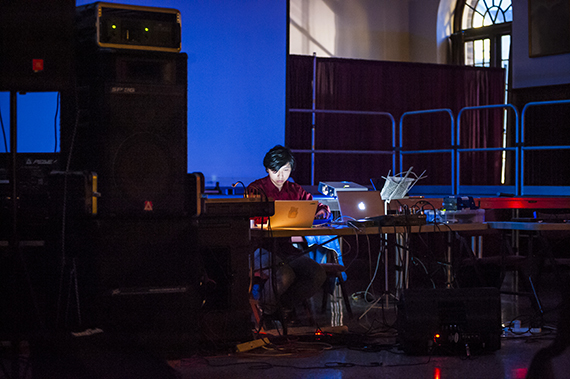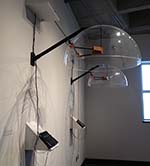
During last Wednesday night’s live performances, Xu Cheng demonstrated circuit bending and presented “Live Body,” a sonic experience. Photo by Ashlee Eve ’14
As birds chirp cheerful songs, a Chinese character duplicates and forms fractal shapes. In sharp contrast, city vibrations serve as the soundtrack for bustling scenes from Shanghai and Hangzhou. Although Revolutions per Minute (RPM) is a sound art exhibition, visitors will travel beyond sight and sound.
The exhibition, which runs until April 26, was launched last week with four days of events including live audio-visual performances, a show at the Ho Tung Visualization Lab, a discussion panel, and workshops.
Featuring the works of more than 30 artists, RPM is the world-premiere survey exhibition of Chinese sound art. It was co-curated by Wenhua Shi, assistant professor of art and art history at Colgate, and Dajuin Yao, artist and director of Open Media Lab at the China Academy of Art. Yao and five of the artists came to campus to lead workshops and perform live.
Shi and Yao shouldered the Herculean task of installing all 35 pieces. The majority are located on the second floor of Little Hall, but others are in unexpected places like the underground tunnel between Olin Hall and the Ho Science Center as well as outdoor spots.
Lane of Cicadas plays springtime sounds from a speaker on the Willow Path bridge. Roars, Thunderings, Explosions… rumbles machine and war sound effects from the top of the Persson Hall steps. In the Village Green, Hong Kong Pavilion and China Pavilion emit Chinese city sounds that provide a juxtaposition to Hamilton’s public space.
Shi and Yao tackled weather- and technology-related challenges with the help of various departments. “They worked day and night for the last few weeks,” Yao said of the engineers, technicians, and others on the campus team. “We’ve had all things to deal with: speakers had to be waterproofed, batteries have to be changed, all these technical things have to be realized.”
Certain pieces are interactive, like What’s in Your Suitcase? by Shi. Scan one of 30 palm-sized plastic suitcases across the top of a wooden box, and you’ll hear a first-person travel tale.
Considered a 10-year retrospective, the survey is a collection of the works exchanged between sound artists who have known each other anywhere from two to 20 years.
“We dug things out and made a conscious choice to think about what pieces represent significant moments of Chinese sound art,” Shi said.
In last week’s workshops, participants created their own sound art. During Electronic Circuit Bending and Effect Box Building, Xu Cheng showed attendees how to solder wires onto a circuit board to make sounds.
“Music can be anything,” said Caitlin Grossjung ’13, the president of Broad Street Records who attended several events. “These installations expand our notions of what sound can be, creating a distinct link between visuals and audio.”
Chase Jackson ’13 signed on to build installations, but he also ended up having his own work, Selfexplanatory, featured. Jackson built the growing piece — which plays unique clips when the user presses one or more of 360 different buttons (there will be 1,000 when it’s done) — for an independent study assignment. Shi was so impressed with the work that it was added in the final stages of the exhibition preparations.
The co-curators are encouraging students and community members to submit their sound art for a closing night presentation at the former Crowe’s Pharmacy downtown. “[It’s meant to] allow everyone to listen to how others interpreted the sound art, how they experienced this exhibit and created their own work,” said Shi.
For more information, visit the RPM website.
